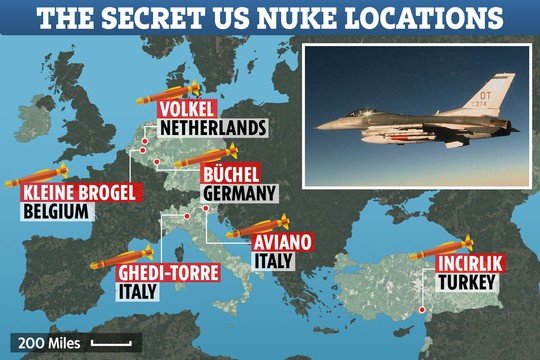Jens Stoltenberg, the 13th secretary general of NATO, says that NATO is in talks to deploy more nuclear weapons and modernize their delivery systems, notes Stephen Bryen, a former US Deputy Under Secretary of Defense.
Stoltenberg told the Telegraph in the UK: "I won't go into operational details about how many nuclear warheads should be operational and which should be stored, but we need to consult on these issues. That's exactly what we're doing." Stoltenberg emphasized that NATO is a "nuclear alliance." He explained: "NATO's aim is, of course, a world without nuclear weapons, but as long as nuclear weapons exist, we will remain a nuclear alliance, because a world where Russia, China and North Korea have nuclear weapons, and NATO does not, is a more dangerous world," he said.
But Stoltenberg could not act on NATO's nuclear deterrent unless deeply coordinated with the United States. Thus the NATO expansion of nuclear weapons is a Biden administration policy and program.
NATO's nuclear deterrence is based on nuclear sharing arrangements. As described officially: “NATO’s nuclear deterrence posture also relies on the United States’ nuclear weapons forward-deployed in Europe, as well as on the capabilities and infrastructure provided by Allies concerned. A number of NATO countries contribute a dual-capable aircraft (DCA) capability to the Alliance. These aircraft are central to NATO’s nuclear deterrence mission and are available for nuclear roles at various levels of readiness. In their nuclear role, the aircraft are equipped to carry nuclear weapons in a conflict, and personnel are trained accordingly.
The United States maintains absolute control and custody of their nuclear weapons forward-deployed in Europe, while Allies provide military support for the DCA mission with conventional forces and capabilities.”
While NATO's nuclear weapons are American, the UK and France have nuclear weapons too.
US nuclear weapons stored in Europe are nuclear gravity bombs that can be launched by NATO aircraft or by the US operating independently of NATO.
Technically nuclear gravity bombs fall into the category of tactical nuclear weapons. The US, UK and France also deploy strategic nuclear weapons in and around Europe. The UK has around 225 nuclear warheads (more than half in storage) for its Trident nuclear submarine program. The British nuclear capability requires US coordination.
France is the only NATO country with a fully independent nuclear arsenal that consists of ballistic missile submarines and a small number of cruise missiles with nuclear warheads. The French have floated the idea of replacing the US nuclear deterrent with a French one and there have been discussions with Germany about the idea. To some degree, Stoltenberg's announcement on upgrading NATO's nuclear alliance could be interpreted as offsetting French pressure to diverge from the US-led deterrent in Europe.
There has long been suspicion in Europe that the US would not launch nuclear weapons to defend European territory because of the risk of a nuclear exchange between Russia and the United States. To an unknown extent, the presence of tactical nuclear weapons (under US control) is intended to enable the US to use the tactical part of its nuclear arsenal reducing the risk of a strategic nuclear exchange with Russia.
Yet it is certainly the case that Stoltenberg's emphasis on NATO as a nuclear alliance was primarily intended to offset fears that Russia could turn to nuclear weapons to settle the Ukraine conflict. …
The Russians have been conducting nuclear exercises and claim to have put nuclear weapons in Belarus, although none have been spotted there as of now. Likewise the US has been flying its strategic bombers close to Russia's borders as a US warning.
It is important to point out that neither the US nor NATO has any treaty obligation, or any other responsibility, to protect Ukraine from a nuclear attack. Therefore, NATO deterrence, at least insofar as it is understood, does not apply to Ukraine in any formal manner. But that does not mean that Stoltenberg, and by proxy the United States, is not shifting the alliance to extending a nuclear umbrella over Ukraine.
One reason to assess this may be the change in strategy underway is the NATO-US decision to unleash long range weapons in Ukraine on Russian territory.
In the context of superpower rivalries and proxy and other conflicts (the Cuban Missile Crisis was not a proxy conflict but a direct confrontation between the US and USSR) NATO-approved attacks on Russian territory appear to cross a dangerous red line. When combined with the no negotiations and no talks, no peace posture of the US and most of Europe on Ukraine, the danger of an expanding conflict, or even one involving nuclear weapons, is increasing. Upgrading nuclear arsenals in that context adds fuel to the fire.
read more in our Telegram-channel https://t.me/The_International_Affairs

 11:40 19.06.2024 •
11:40 19.06.2024 •























